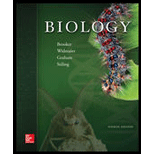
Introduction: The exchange of oxygen and carbon dioxide in water or on land requires respiratory organs that are appropriate for the challenges presented by different environmental conditions. Insects use tracheal systems to exchange gases with the air.
Answer to Problem 1TY
Correct answer: The partial pressure of oxygen provides the driving force for the diffusion of oxygen across the surface of respiratory organs and in the blood. Hence, the correct answer is option a.
Explanation of Solution
Reason for correct answer:
All gases diffuse from the regions of high pressure to the regions of low pressure. This movement of gases along the pressure gradients is similar to the diffusion of dissolved solutes from the regions of high concentration to low concentration.
Option a. is given as “difference in the partial pressure of oxygen (Po2) in the environment and in the blood”.
The difference in the partial pressure of oxygen in the air and the blood forms a pressure gradient. This gradient is responsible for the movement of oxygen across the cells of a respiratory organ. Hence, the correct answer is option a.
Reasons for the incorrect answer:
Option b. is given as, “humidity”.
Humidity has an impact on the movement of gases across the cells of a respiratory organ. However, it does not act as a driving force for diffusion of gases. Hence, option b. is incorrect.
Option c. is given as, “partial pressure of carbon dioxide (Pco2) in the blood”.
The partial pressure of carbon dioxide in the blood plays an indirect role in the movement of gases across the surface of a respiratory organ. Hence, option c. is incorrect.
Option d. is given as, “air temperature”.
The air temperature is one of the factors that decide the rate of diffusion of gases across the cells of a respiratory organ. However, it does not act as driving force for the movement of oxygen across the surface of the respiratory organ. Hence, option d. is incorrect.
Option e. is given as, “Pco2 in the atmosphere”.
The partial pressure of carbon dioxide in the atmosphere and the body plays an important role in the movement of carbon dioxide across the cells of a respiratory organ. Hence, option e. is incorrect.
Hence, the options b., c., d. and e. are incorrect.
The difference in the partial pressure of oxygen in the environment and the blood acts as a driving force for the movement of oxygen across the cells of a respiratory organ.
Want to see more full solutions like this?
Chapter 48 Solutions
Biology
- Outline the negative feedback loop that allows us to maintain a healthy water concentration in our blood. You may use diagram if you wisharrow_forwardGive examples of fat soluble and non-fat soluble hormonesarrow_forwardJust click view full document and register so you can see the whole document. how do i access this. following from the previous question; https://www.bartleby.com/questions-and-answers/hi-hi-with-this-unit-assessment-psy4406-tp4-report-assessment-material-case-stydu-ms-alecia-moore.-o/5e09906a-5101-4297-a8f7-49449b0bb5a7. on Google this image comes up and i have signed/ payed for the service and unable to access the full document. are you able to copy and past to this response. please see the screenshot from google page. unfortunality its not allowing me attch the image can you please show me the mathmetic calculation/ workout for the reult sectionarrow_forward
- Skryf n kortkuns van die Egyptians pyramids vertel ñ story. Maximum 500 woordearrow_forward1.)What cross will result in half homozygous dominant offspring and half heterozygous offspring? 2.) What cross will result in all heterozygous offspring?arrow_forward1.Steroids like testosterone and estrogen are nonpolar and large (~18 carbons). Steroids diffuse through membranes without transporters. Compare and contrast the remaining substances and circle the three substances that can diffuse through a membrane the fastest, without a transporter. Put a square around the other substance that can also diffuse through a membrane (1000x slower but also without a transporter). Molecule Steroid H+ CO₂ Glucose (C6H12O6) H₂O Na+ N₂ Size (Small/Big) Big Nonpolar/Polar/ Nonpolar lonizedarrow_forward
- what are the answer from the bookarrow_forwardwhat is lung cancer why plants removes liquid water intead water vapoursarrow_forward*Example 2: Tracing the path of an autosomal dominant trait Trait: Neurofibromatosis Forms of the trait: The dominant form is neurofibromatosis, caused by the production of an abnormal form of the protein neurofibromin. Affected individuals show spots of abnormal skin pigmentation and non-cancerous tumors that can interfere with the nervous system and cause blindness. Some tumors can convert to a cancerous form. i The recessive form is a normal protein - in other words, no neurofibromatosis.moovi A typical pedigree for a family that carries neurofibromatosis is shown below. Note that carriers are not indicated with half-colored shapes in this chart. Use the letter "N" to indicate the dominant neurofibromatosis allele, and the letter "n" for the normal allele. Nn nn nn 2 nn Nn A 3 N-arrow_forward
 Human Anatomy & Physiology (11th Edition)BiologyISBN:9780134580999Author:Elaine N. Marieb, Katja N. HoehnPublisher:PEARSON
Human Anatomy & Physiology (11th Edition)BiologyISBN:9780134580999Author:Elaine N. Marieb, Katja N. HoehnPublisher:PEARSON Biology 2eBiologyISBN:9781947172517Author:Matthew Douglas, Jung Choi, Mary Ann ClarkPublisher:OpenStax
Biology 2eBiologyISBN:9781947172517Author:Matthew Douglas, Jung Choi, Mary Ann ClarkPublisher:OpenStax Anatomy & PhysiologyBiologyISBN:9781259398629Author:McKinley, Michael P., O'loughlin, Valerie Dean, Bidle, Theresa StouterPublisher:Mcgraw Hill Education,
Anatomy & PhysiologyBiologyISBN:9781259398629Author:McKinley, Michael P., O'loughlin, Valerie Dean, Bidle, Theresa StouterPublisher:Mcgraw Hill Education, Molecular Biology of the Cell (Sixth Edition)BiologyISBN:9780815344322Author:Bruce Alberts, Alexander D. Johnson, Julian Lewis, David Morgan, Martin Raff, Keith Roberts, Peter WalterPublisher:W. W. Norton & Company
Molecular Biology of the Cell (Sixth Edition)BiologyISBN:9780815344322Author:Bruce Alberts, Alexander D. Johnson, Julian Lewis, David Morgan, Martin Raff, Keith Roberts, Peter WalterPublisher:W. W. Norton & Company Laboratory Manual For Human Anatomy & PhysiologyBiologyISBN:9781260159363Author:Martin, Terry R., Prentice-craver, CynthiaPublisher:McGraw-Hill Publishing Co.
Laboratory Manual For Human Anatomy & PhysiologyBiologyISBN:9781260159363Author:Martin, Terry R., Prentice-craver, CynthiaPublisher:McGraw-Hill Publishing Co. Inquiry Into Life (16th Edition)BiologyISBN:9781260231700Author:Sylvia S. Mader, Michael WindelspechtPublisher:McGraw Hill Education
Inquiry Into Life (16th Edition)BiologyISBN:9781260231700Author:Sylvia S. Mader, Michael WindelspechtPublisher:McGraw Hill Education





